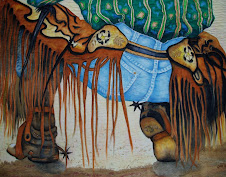Before I begin the finishing process, I usually block my quilts (not shown) by dampening them, laying them flat on a pinable surface(eg. a big board ironing board for smaller quilts) or a solid but slightly soft surface ( like carpet covered with a clean bed sheet). Once dampened, and smooshed ( "technical term"..not really ) flat, the quilt is pinned along it's perimeter and allowed to air dry. Once dry and flat... as IS shown here, I measure and mark the intended edges of the piece. In this example, I again used a Frixion Pen and ruler for straight line marking. "Don't be afraid to eliminate some area (as in the top of the piece below) if it ultimately doesn't seem to add anything positive to the cause.. or also as in this case, it seems distracting.
Before I cut away any excess, I straight stitch along the drawn line. (I've done it free motion but you of course could use a different pressure foot even including a quilting foot. If you do this, consider whether you need reduce downward pressure on a pressure foot other than what I've done as free motion. Bottom line... Free motion works for me, and I don't have to change anything.) WHY DO THIS?: This stitching process will keep loose thread edges from popping up once the excess is cut away.
Notice, when I cut away... I do it just to the outer edge of the previously stitched line.
Now we are ready to add the facing fabric which in this case will exactly match the backing. To be shown next post.
Sunday, March 17, 2013
Subscribe to:
Post Comments (Atom)








2 comments:
this made me smile because this is how I do a piece too - except - when I'm done stitching you would hear me call my husband - ask him to square my quilt - him groan out load - and then ask how much can he take off. I tell him - always - whatever it takes! Gotta love a man who knows how to work a huge square and chalk line!
Well, this is a tip worth trying! Thanks so much...I've always dampen mine/pin/dry/etc. but the stitching straight line is so clever.
Post a Comment